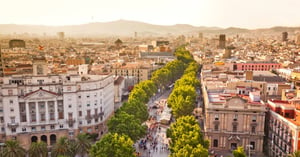This smart city portrait provides an overview on the smart city strategy and intelligent solutions implemented in the City of Barcelona. The city is no newcomer to the smart city scene. In 2011 it launched a project designed to make the city more innovative, listing the sustainability of energy use and of mobility, open data initiatives, flexible smart services and social initiatives as key areas for development, and it encouraged connections among researchers in both the public and private sectors with a focus on these topics.
One major early step for Barcelona was to establish new technological infrastructure on a massive scale to support and improve upon the city’s services. It created citywide networks of different types of sensors, providing real-time feedback on everything from air quality to noise, energy and waste management. Coupled with free WiFi around the city, this new level of connectivity and data collection allowed Barcelona to become a testbed for smart projects driven by the Internet of Things.
Barcelona was officially recognized as a smart city back in 2014 by the European Commission, taking the very first European Capital of Innovation prize for "introducing the use of new technologies to bring the city closer to citizens". The city had indeed pursued the application of technology to generate smart solutions for the problems most relevant to its citizens – but with mixed results.

"Barcelona shows us that it is people, not technology, that make a city smarter. Cities across the world should wisely consider Barcelona's lessons learned when embarking on their own smart city journey", says Dr. Alexander Gelsin, Managing Director at bee smart city.
The Catalonian capital is now taking steps to re-focus its smart city strategy toward a less top-down-style, more citizen-centric approach, in agreement with bee smart city’s assessment of the use of technology to make cities smarter. It plans to sort out the successes from the failures and to ask how its technology and its initiatives can be applied differently to better serve its citizens. This new focus was confirmed in June 2016 with the appointment of a new Chief Technology and Digital Innovation Officer, Francesca Bria, to the Barcelona City Council. Bria’s strong background in digital ecosystems, in terms of their collaborative creation and their socio-economic impact, puts her in a good position to respond to the brief she was given for the council position: “to rethink the smart city from the ground up”.
Barcelona – A Smart City Getting Smarter
Bria’s task is to ensure that the development and implementation of smart technologies in Barcelona matches the evolving goals of the city, starting with an examination of what worked and what didn’t. There are a few clear success stories: based on feedback from its sensor networks, the city has been able to make reductions in its water use on public lands – and consequent monetary savings – and to improve its public transportation services, including providing live updates to travellers so that they can make smarter transport choices.
One less helpful outcome involved the use of electromagnetic street-side parking sensors, which were intended to show the availability of spaces (smart parking) but which were triggered by the presence of trains stopping in underground rail stations, leaving empty spaces to be incorrectly signed as occupied.
Results like these are now allowing both the city of Barcelona and its US-based technology partner Cisco to refine their smart systems, or to abandon the projects which had negative outcomes in favour of supporting the more useful ones.

"Smart city efforts often fail in the implementation of smart city solutions. The key to getting smarter is to connect strategy design with delivery. It begins with asking the right questions and ends with a clear view of who is accountable“, says Bart Gorynski, Managing Director at bee smart city.
But Barcelona’s smart city strategy is being adapted not only to further serve its citizens but to include them more directly in the development of their city. Through both face-to-face and electronic consultation, the city aims to increase the transparency of its government and has proposed the creation of an open platform where the data being gathered by its vast Internet of Things can be shared with the people and companies responsible for producing it. See also our article: Benefits of open data for smart cities.
Barcelona’s Internet of Things
An important next step for Barcelona will be to unify its platforms so that more of its technological systems can be integrated, allowing new functionalities and enabling the generation of a single go-to point for the volumes of collected data. Data ownership and data protection issues must then be addressed so that Barcelona can make this important resource – its ‘city data commons’ – available to its people and businesses, who could use the information to strengthen their economic position.
Some of the city’s more recent plans reveal Barcelona’s focus on its key problems, and they promise to make even better use of its established Internet of Things. Examples include:
- The Air Quality Improvement Plan, involving various political and technological initiatives designed to reduce the level of air pollution in the city.
- The Urban Mobility Plan, set to ensure "safe, sustainable, equitable and efficient mobility".
- Affordable Housing – Barcelona is putting together a register of rental properties and vacant properties, which it plans to make available as a map online. The creation of this map and listing should make it easier to identify affordable housing, which is a major problem in many cities worldwide. The city will also target businesses whose practices can lead to rises in housing prices.
Barcelona’s Smart City Solutions
These three broad plans are by no means the limit of Barcelona’s smart city initiatives. It has invested heavily in technology-based specific city services and smart city solutions to tackle the biggest problems for its citizens. Making the city greener has been a clear positive outcome of many of these projects.
Sustainability Initiatives
The city’s official website offers access to several smart city services directly. For example, up-to-date assessments of air quality, in terms of NO2 and PM10 concentrations, are provided on the city website’s home page for different locations around the city. The monitor is colour-coded and links directly to a page displaying a map of the air quality across the city, accompanied by explanations of the sources of pollution, with a big finger, pointed at the use of cars. This has become one of the key concerns for Barcelona’s citizens, who live in the city with the “highest vehicle density in Europe”. The regulations governing pollution sources are also outlined, along with how they are being applied and developed to reduce pollution and improve the city’s air.
As mentioned previously, sensors on public lands have helped to reduce water consumption in those spaces, which has led to both big water and cost savings for the city.
Street lights across Barcelona were replaced with a sensor network and LED-based lighting (read more about: smart lighting), which is significantly more energy efficient, reducing the waste heat given off by the old lamps and leading to cost savings for the city. Allowing control over the level of lighting also offered the unexpected benefit of being able to attract people toward specific locations of interest around the city.
Barcelona’s smart waste disposal system sees its citizens depositing their household waste into smart bins, which suck the waste into underground storage using a vacuum. This reduces noise pollution from collection vehicles and the smell of rubbish waiting to be collected. It also allows the city to monitor the level of waste coming from different areas and to optimize waste collection, which reduces both the time and resources required for this important service. The incineration of waste is later used to generate energy for heating systems. Read more about Smart Waste Management.
Enabling Initiatives
Barcelona’s Fab Labs, hosted by the Institute for Advanced Architecture of Catalonia, are classrooms where citizens “can learn about the principles, applications and implications of digital manufacturing technology”. The Fab Labs allow citizens access to the information and tools needed to innovate technologically, allowing their engagement with and informed participation in the city’s tech-driven smart city projects.
For those who already have the skills, Barcelona has created 22@Barcelona, a space designed to attract startups, "concentrating talent" to develop new technologies that make the most of the data being produced by its Internet of Things (IoT). This has already led to several successful pilot projects, including some market successes centred on mobility and parking. Barcelona’s technology partner Cisco also plans to establish an innovation centre there to research the Internet of Everything, its third in the world and the only one in Europe.
Encouraging the further participation of citizens in government processes, Decidim.Barcelona is Barcelona’s ‘participatory democracy platform’. It allows the people to see and discuss proposals being put forward by their government, as well as to submit their own.
Mobility Initiatives
The improvements to Barcelona’s public transportation system mentioned above also include an increase in the frequency of buses, making it a more effective system, and the addition of USB charging stations at its new interactive, solar-powered bus stops.
Back in 2007, Barcelona set up a bike-sharing program for city residents, ‘Bicing’, which now boasts over 120,000 subscribers. Each subscriber is provided with a card to unlock any of the city’s bikes, which are free to use for short journeys of up to thirty minutes. While longer journeys using the bikes are not encouraged, such use attracts only a small hourly fee thereafter.
Barcelona now encourages the use of electronic cars to reduce reliance on the more polluting variety, and the city has now initiated a pedestrian-first policy in a certain area known as its ‘superblock’, restricting all vehicular traffic to no more than 10 kph.
As you can see, Barcelona is an innovative smart city, but other Spanish cities are smart too. Read our article to increase your knowledge about smart sustainable cities in Spain.

“Cities that embark on the smart city journey should start by harvesting ‘low-hanging fruit’. By adapting or replicating the best practices of leading smart cities, quick wins can be generated with minimal resources, providing more time, money, and personnel for follow-up projects”, recommends Thomas Müller, Co-Founder at bee smart city.
ACCESS BEST PRACTICE SMART CITY SOLUTIONS
Explore hundreds of smart solutions that have been implemented successfully in over 1,000 cities and communities around the world. Join other smart city experts in the world's largest smart city community to share expertise, gain knowledge and grow your network.


